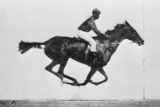What made the undefeated 18th Century horse, Eclipse, such a great champion. The genetics research is giving insights into the origins of the world's thoroughbred racing stock, including the sensational 1867 Derby winner, Hermit.
 |
| Eclipse is one of the Greatest Racehorses of all time |
Eclipse was never beaten when he ran from 1769-1770 and was retired largely because of the lack of competition. Super stallion Eclipse's descendants include Kauto Star and Desert Orchid and almost all thoroughbred racehorses.Scientists have succeeded in examining Hermit’s origins and in taking a sample of DNA from one of Eclipse's teeth as part of a project to unlock the 'lifecodes' of great thoroughbreds. Professor Matthew Binns, an equine genetics expert from the RVC, who is part of the project, said: “Eclipse was probably the greatest racehorses in history. He won 18 races and usually by 10 or 20 furlongs. Flat races were much longer in those days. Genetics is playing an ever bigger role in equine science as researchers try to understand what horses more susceptible to disease or more likely to break down in training.” Research already shows that today's racehorses can trace their line to a very small group of animals imported from the Near East and North Africa in the early 1700s.
 |
| Eclipse and his Groom , By George Stubbs |
The RVC's work is adding further detail to this story and it should also show up which genetic traits have come through the 30 or so generations since the foundation of the stock.
The RVC has also set its Structure and Motion workgroup on to Eclipse. Experts at the Royal Veterinary College combined what was known about the heroic horse from his paintings, CT scans of his skeleton and reports of his races and created computer models of the horse. Using portraits of Eclipse and contemporary accounts of the horse running the researchers reconstructed one of its legs and have discovered that its legendary speed may have been due to its 'averageness'. In short, a great racehorse needs to be more than just quick footed - it must also be rather average. The research involved analysing Eclipse's skeleton to develop models of horse movement. Using the models the research team built 'theoretical limbs' on a computer and tested answers to questions on not only why Eclipse was so fast but also why horses can remain balanced when each leg is off the ground for 80 per cent of the time during gallop and what limits a horse's maximum gallop speed.
Dr Alan Wilson, who led the study, said: "All the factors for speed were perfectly matched. A key ability for a fast horse is to be able to bring its legs forward quickly, which is difficult for large animals with long limbs. Eclipse was smaller than modern racehorses. Rather than being some freak of nature with incredible properties, he was actually just right in absolutely every way."
Royal Veterinary College. "Why Was The Racehorse Eclipse So Good?." ScienceDaily, 11 Jun. 2007. Web. 10 Apr. 2012.

















